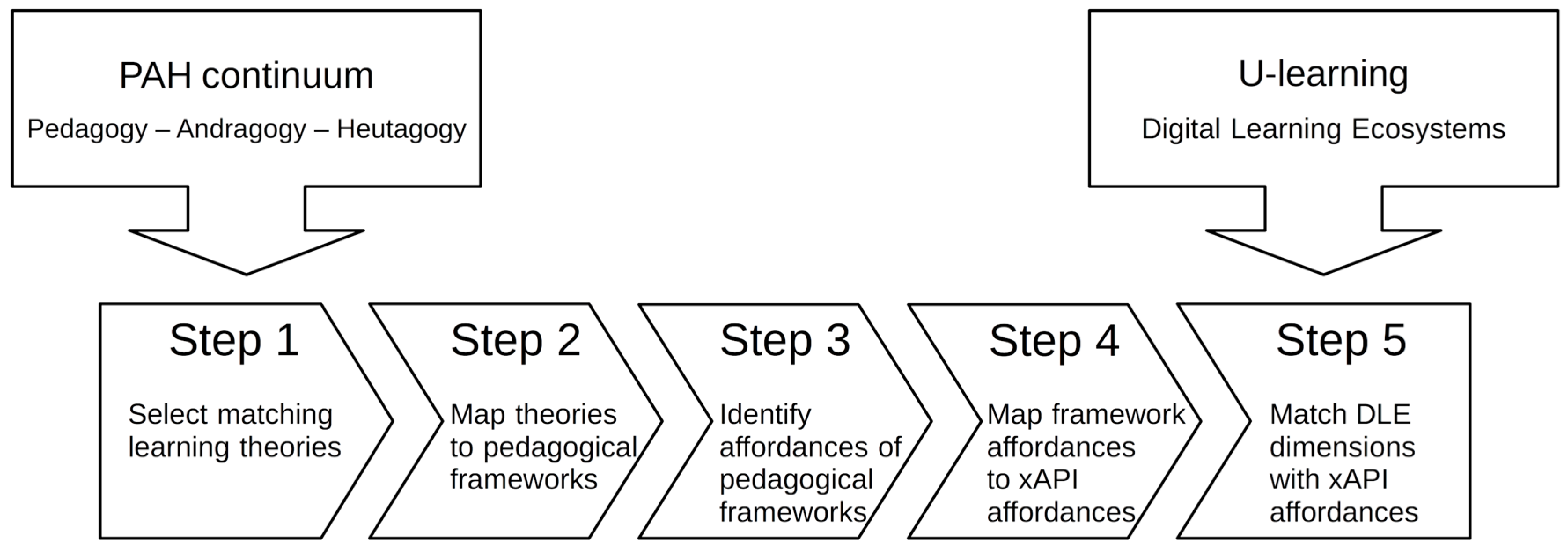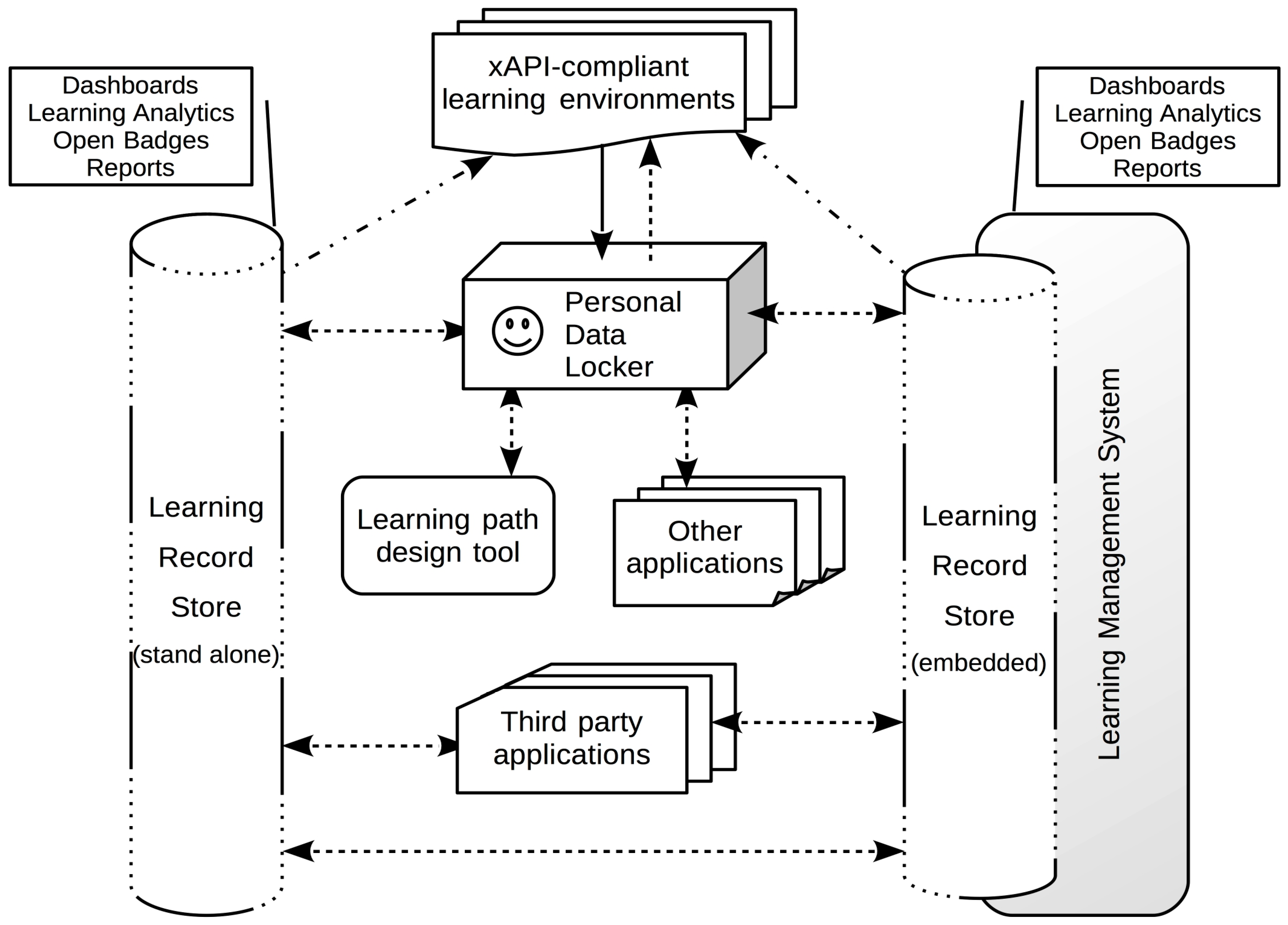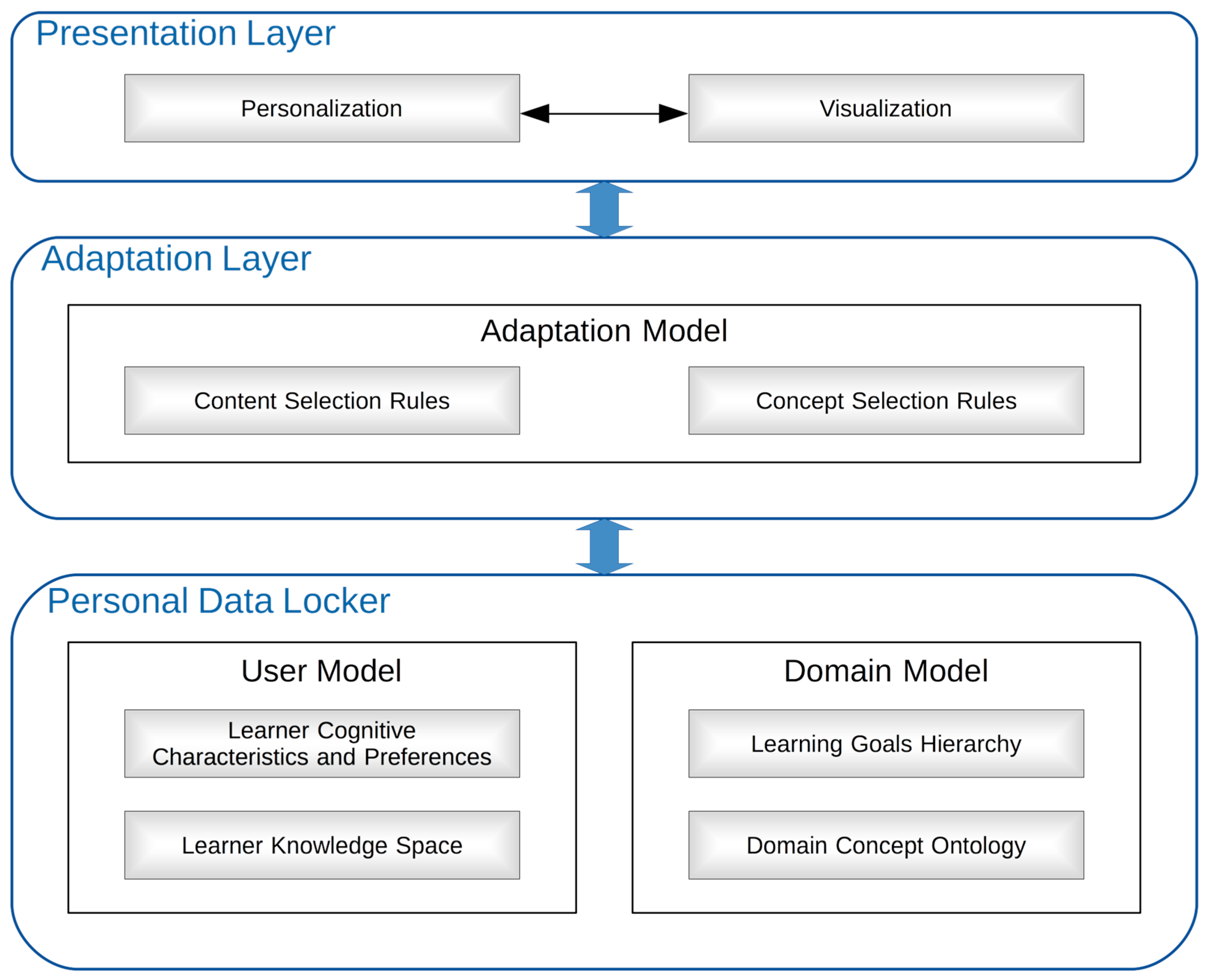Ubiquitous Learning Architecture to Enable Learning Path Design across the Cumulative Learning Continuum
Abstract
:1. Introduction
2. Theoretical Framework
2.1. Digital Learning Ecosystems
2.2. Designing with Affordances
2.3. The PAH Continuum
2.4. Learning Path Design across the Learning Continuum
- Importance in contemporary mainstream pedagogy;
- Compliance with the concept of affordances;
- Compliance with DLEs concept and other components of the framework;
- Frameworks should cover learning processes and their outcomes from both the learners’ and the facilitator’s perspectives.
3. Proposed Framework for Pedagogy-Driven Ubiquitous Learning
3.1. Learning Path Design Framework
3.2. Learning Path Design System Architecture
4. Discussion
5. Conclusions
Acknowledgments
Author Contributions
Conflicts of Interest
References
- Hwang, G.-J.; Tsai, C.-C.; Yang, S.J.H. Criteria, Strategies and Research Issues of Context-Aware Ubiquitous Learning. J. Educ. Technol. Soc. 2008, 11, 81–91. [Google Scholar]
- Casey, D. u-Learning = e-Learning + m-Learning. In E-Learn 2005–World Conference on E-Learning in Corporate, Government, Healthcare, and Higher Education; Richards, G., Ed.; Association for the Advancement of Computing in Education (AACE): Vancouver, BC, Canada, 2005; pp. 2864–2871. [Google Scholar]
- Yahya, S.; Ahmad, E.A.; Jalil, K.A. The definition and characteristics of ubiquitous learning: A discussion. Int. J. Educ. Dev. Using Inf. Commun. Technol. 2010, 6, 117–127. [Google Scholar]
- Hsu, T.Y.; Chiou, C.K.; Tseng, J.C.R.; Hwang, G.J. Development and Evaluation of an Active Learning Support System for Context-Aware Ubiquitous Learning. IEEE Trans. Learn. Technol. 2016, 9, 37–45. [Google Scholar] [CrossRef]
- Yin, P.-Y.; Chuang, K.-H.; Hwang, G.-J. Developing a context-aware ubiquitous learning system based on a hyper-heuristic approach by taking real-world constraints into account. Univers. Access Inf. Soc. 2016, 15, 315–328. [Google Scholar] [CrossRef]
- Chen, C.-C.; Huang, T.-C. Learning in a u-museum: Developing a context-aware ubiquitous learning environment. Comput. Educ. 2012, 59, 873–883. [Google Scholar] [CrossRef]
- Din, F.S. The Functions of Class Size Perceived by Chinese Rural School Teachers. Natl. Forum Appl. Educ. Res. J. 1999, 12, 1–6. [Google Scholar]
- Akkerman, S.; Admiraal, W.; Huizenga, J. Storification in history education: A mobile game in and about medieval Amsterdam. Comput. Educ. 2009, 52, 449–459. [Google Scholar] [CrossRef]
- Hwang, G.-J.; Hung, P.-H.; Chen, N.-S.; Liu, G.-Z. Mindtool-Assisted In-Field Learning (MAIL): An Advanced Ubiquitous Learning Project in Taiwan. J. Educ. Technol. Soc. 2014, 17, 4–16. [Google Scholar]
- Chiou, C.-K.; Tseng, J.C. R.; Hwang, G.-J.; Heller, S. An adaptive navigation support system for conducting context-aware ubiquitous learning in museums. Comput. Educ. 2010, 55, 834–845. [Google Scholar] [CrossRef]
- Hwang, G.-J.; Kuo, F.-R.; Yin, P.-Y.; Chuang, K.-H. A Heuristic Algorithm for planning personalized learning paths for context-aware ubiquitous learning. Comput. Educ. 2010, 54, 404–415. [Google Scholar] [CrossRef]
- Chu, H.-C.; Hwang, G.-J.; Tsai, C.-C. A knowledge engineering approach to developing mindtools for context-aware ubiquitous learning. Comput. Educ. 2010, 54, 289–297. [Google Scholar] [CrossRef]
- Chen, C.M.; Li, Y.L.; Chen, M.C. Personalized Context-Aware Ubiquitous Learning System for Supporting Effectively English Vocabulary Learning. In Proceedings of the IEEE International Conference on Advanced Learning Technologies, Niigata, Japan, 18–20 July 2007; pp. 628–630.
- Liu, T.-C.; Peng, H.; Wu, W.-H.; Lin, M.-S. The Effects of Mobile Natural-Science Learning Based on the 5E Learning Cycle: A Case Study. J. Educ. Technol. Soc. 2009, 12, 344–358. [Google Scholar]
- Shih, J.; Hwang, G.; Chu, Y.; Chuang, C. An investigation-based learning model for using digital libraries to support mobile learning activities. Electron. Libr. 2011, 29, 488–505. [Google Scholar] [CrossRef]
- Hwang, G.J.; Wu, P.H.; Zhuang, Y.Y.; Huang, Y.M. Effects of the inquiry-based mobile learning model on the cognitive load and learning achievement of students. Interact. Learn. Environ. 2013, 21, 338–354. [Google Scholar] [CrossRef]
- Dunlap, J.C.; Grabinger, S. Preparing Students for Lifelong Learning: A Review of Instructional Features and Teaching Methodologies. Perform. Improv. Q. 2003, 16, 6–25. [Google Scholar] [CrossRef]
- Candy, P.C. Self-Direction for Lifelong Learning: A Comprehensive Guide to Theory and Practice; Higher and Adult Education Series; John Wiley & Sons: Hoboken, NJ, USA, 1991. [Google Scholar]
- Tattersall, C.; Manderveld, J.; van den Berg, B.; van Es, R.; Janssen, J.; Koper, R. Self organising wayfinding support for lifelong learners. Educ. Inf. Technol. 2005, 10, 109–121. [Google Scholar] [CrossRef]
- Knapper, C.K.; Cropley, A.J. Lifelong Learning in Higher Education, 3rd ed.; Kogan Page Limited: London, UK, 2000. [Google Scholar]
- Luckin, R.; Clark, W.; Garnett, F.; Whitworth, A.; Akass, J.; Cook, J.; Day, P.; Ecclesfield, N.; Hamilton, T.; Robertson, J. Learner-generated contexts: A framework to support the effective use of technology for learning. In Web 2.0-Based E-Learning: Applying Social Informatics for Tertiary Teaching; IGI Global: Hershey, PA, USA, 2010; pp. 70–84. [Google Scholar]
- Canning, N. Playing with heutagogy: Exploring strategies to empower mature learners in higher education. J. Furth. High. Educ. 2010, 34, 59–71. [Google Scholar] [CrossRef]
- Blaschke, L. Heutagogy and lifelong learning: A review of heutagogical practice and self-determined learning. Int. Rev. Res. Open Distrib. Learn. 2012, 13, 56–71. [Google Scholar]
- Garnett, F.; O’Beirne, R. Putting heutagogy into learning. In Self-Determined Learning: Heutagogy in Action; Hase, S., Kenyon, C., Eds.; Bloomsbury Academic: London, UK, 2013; pp. 131–143. [Google Scholar]
- Koper, R. Modelling Units of Study from a Pedagogical Perspective: The Pedagogical Meta-Model behind EML; OTEC working paper; Open University of the Netherlands: Heerlen, The Netherland, 2001; p. 40. [Google Scholar]
- Laanpere, M.; Põldoja, H.; Kikkas, K. The second thoughts about pedagogical neutrality of LMS. In Proceedings of IEEE International Conference on Advanced Learning Technologies, Joensuu, Finland, 30 August–1 September 2004; pp. 807–809.
- Friesen, N. Learning objects and standards: Pedagogical neutrality and engagement. In Proceedings of the IEEE International Conference on Advanced Learning Technologies, Joensuu, Finland, 30 August–1 September 2004; pp. 1070–1071.
- Laanpere, M.; Pata, K.; Normak, P.; Põldoja, H. Pedagogy-Driven Design of Digital Learning Ecosystems. Comput. Sci. Inf. Syst. 2014, 11, 419–442. [Google Scholar] [CrossRef]
- Lombardo, M.M.; Eichinger, R.W. The Career Architect Development Planner, 1st ed.; Lominger Limited: Minneapolis, MN, USA, 1996. [Google Scholar]
- Pontefract, D. Flat Army: Creating a Connected and Engaged Organization; Jossey-Bass: San Francisco CA, USA, 2013. [Google Scholar]
- Laanpere, M.; Põldoja, H.; Normak, P. Designing dippler—A next-generation TEL system. In Open and Social Technologies for Networked Learning: IFIP WG 3.4 International Conference, OST 2012, Tallinn, Estonia, July 30–August 3, 2012, Revised Selected Papers; Ley, T., Ruohonen, M., Laanpere, M., Tatnall, A., Eds.; Springer: Berlin/Heidelberg, Germany, 2013; pp. 91–100. [Google Scholar]
- Uden, L.; Wangsa, I.T.; Damiani, E. The future of E-learning: E-learning ecosystem. In Proceedings of the 2007 Inaugural IEEE-IES Digital EcoSystems and Technologies Conference, Cairns, Australia, 21–23 February 2007; pp. 113–117.
- Ficheman, I.K.; de Deus Lopes, R. Digital learning ecosystems: Authoring, collaboration, immersion and mobility. In Proceedings of the 7th International Conference on Interaction Design and Children, IDC ’08; ACM: New York, NY, USA, 2008; pp. 9–12. [Google Scholar]
- Reyna, J. Digital Teaching and Learning Ecosystem (DTLE): A Theoretical Approach for Online Learning Environments. In Proceedings of ASCILITE—Australian Society for Computers in Learning in Tertiary Education Annual Conference 2011; Australasian Society for Computers in Learning in Tertiary Education: Hobart, Australia, 2011; pp. 1083–1088. [Google Scholar]
- Gibson, J.J. The Ecological Approach to Visual Perception; Psychology Press: New York, NY, USA, 2015. [Google Scholar]
- Overhill, H.J.J. Gibson and Marshall McLuhan: A survey of terminology and a proposed extension of the theory of affordances. Proc. Am. Soc. Inf. Sci. Technol. 2012, 49, 1–4. [Google Scholar] [CrossRef]
- Norman, D. The Design of Everyday Things; Doubleday: New York, NY, USA, 1988. [Google Scholar]
- Bower, M. Affordance analysis—Matching learning tasks with learning technologies. Educ. Media Int. 2008, 45, 3–15. [Google Scholar] [CrossRef]
- Kaptelinin, V.; Nardi, B. Affordances in HCI: Toward a Mediated Action Perspective. In Proceedings of the SIGCHI Conference on Human Factors in Computing Systems, CHI’12, Austin, TX, USA, 5–10 May 2012; pp. 967–976.
- Kirschner, P.; Strijbos, J.-W.; Kreijns, K.; Beers, P.J. Designing electronic collaborative learning environments. Educ. Technol. Res. Dev. 2004, 52, 47–66. [Google Scholar] [CrossRef] [Green Version]
- Kreijns, K.; Kirschner, P.A.; Jochems, W. The Sociability of Computer-Supported Collaborative Learning Environment. J. Educ. Technol. Soc. 2002, 5, 8–22. [Google Scholar]
- Kirschner, P.A. Can we support CSCL? Educational, social and technological affordances for learning. In Three Worlds of CSCL: Can We Support CSCL; Kirschner, P.A., Ed.; Open Universiteit Netherlands: Heerlen, The Netherlands, 2002; pp. 7–47. [Google Scholar]
- Fiedler, S.; Pata, K. Distributed Learning Environments and Social Software: In Search for a Framework of Design. In Handbook of Research on Social Software and Developing Community Ontologies; Hatzipanagos, S., Warburton, S., Eds.; IGI Global: Hershey, PA, USA, 2009; pp. 145–158. [Google Scholar]
- Pata, K.; Väljataga, T. Collaborating across national and institutional boundaries in higher education—The decentralized iCamp approach. In Proceedings of EdMedia: World Conference on Educational Media and Technology 2007; Montgomerie, C., Seale, J., Eds.; Association for the Advancement of Computing in Education (AACE): Vancouver, BC, Canada, 2007; pp. 353–362. [Google Scholar]
- Pata, K. Modeling spaces for self-directed learning at university courses. J. Educ. Technol. Soc. 2009, 12, 23–43. [Google Scholar]
- Pata, K. Revising the Framework of Knowledge Ecologies: How Activity Patterns Define Learning Spaces. In Educational Social Software for Context-Aware Learning: Collaborative Methods and Human Interaction; Lambropoulos, N., Romero, M., Eds.; IGI Global: Hershey, PA, USA, 2010; pp. 241–267. [Google Scholar]
- Normak, P.; Pata, K.; Kaipainen, M. An Ecological Approach to Learning Dynamics. J. Educ. Technol. Soc. 2012, 15, 262–274. [Google Scholar]
- Tin Can API. Available online: http://tincanapi.com (accessed on 14 July 2016).
- Experience API (xAPI). Available online: http://experienceapi.com (accessed on 14 July 2016).
- Layers of the Tin Can Onion. Available online: http://tincanapi.com/wp-content/assets/Onion/Layers-of-the-Tin-Can-Onion.pdf (accessed on 14 July 2016).
- Human Performance (Big) Data Specification. Available online: https://adlnet.gov/adl-assets/uploads/2016/01/xAPI_OnePager_FINAL.pdf (accessed on 14 July 2016).
- Kerka, S. Self-Directed Learning. Myths and Realities; ERIC Clearinghouse on Adult, Career, and Vocational Education: Columbus, OH, USA, 1999. [Google Scholar]
- Gerstein, J. Moving from Education 1.0 through Education 2.0 towards Education 3.0. In Experiences in Self-Determined Learning; Blaschke, L.M., Kenyon, C., Hase, S., Eds.; Create Space Independent Publishing Platform: Milton Keynes, UK, 2014; pp. 83–98. [Google Scholar]
- Essentialism. Available online: http://www.siue.edu/~ptheodo/foundations/essentialism.html (accessed on 30 July 2016).
- Schaffarzyk, H. The Enhanced Version of xAPI (xAPI extended). Available online: https://personal-data-locker.org/en/ (accessed on 2 August 2016).
- Karampiperis, P.; Sampson, D. Adaptive Learning Resources Sequencing in Educational Hypermedia Systems. Educ. Technol. Soc. 2005, 8, 128–147. [Google Scholar]
- Galanis, N.; Mayol, E.; Alier, M.; Garcia-Peñalvo, F.J. Designing an Informal Learning Support Framework. In Proceedings of the 3rd International Conference on Technological Ecosystems for Enhancing Multiculturality, Porto, Portugal, 7–9 October 2015; pp. 461–466.
- Janssen, J.; Berlanga, A.; Vogten, H.; Koper, R. Towards a learning path specification. Int. J. Contin. Eng. Educ. Lifelong Learn. 2008, 18, 77–97. [Google Scholar] [CrossRef]
- Baajour, H.; Magoulas, G.D.; Poulovassilis, A. Modelling the lifelong learner in a services-based environment. In Proceedings of the ITA 2007—2nd International Conference on Internet Technologies and Applications, Wrexham, North East Wales, UK, 4–7 September 2007; pp. 181–190.
- Instone, K. Information Architecture and Personalization: An Information Architecture-Based Framework for Personalization Systems; Argus Center: Melbourne, Australia, 2000. [Google Scholar]
- Marwick, A.D. Knowledge management technology. IBM Syst. J. 2001, 40, 814–830. [Google Scholar] [CrossRef]
- De Freitas, S.; Magoulas, G.; Oliver, M.; Papamarkos, G.; Poulovassilis, A.; Harrison, I.; Mee, A. L4all-a web-service based system for lifelong learners. In The Learning Grid Handbook: Concepts, Technologies and Applications: The Future of Learning; IOS Press: Amsterdam, The Netherlands, 2008; pp. 143–155. [Google Scholar]
- Brusilovsky, P.; Millán, E. User models for adaptive hypermedia and adaptive educational systems. In The Adaptive Web; Brusilovsky, P., Kobsa, A., Nejdl, W., Eds.; Springer: Berlin, Heidelberg, Germany, 2007; pp. 3–53. [Google Scholar]
- 70:20:10. Available online: https://tincanapi.com/70-20-10/ (accessed on 5 August 2016).




| Dimensions | 1st generation | 2nd generation | 3rd generation |
|---|---|---|---|
| Software architecture | Desktop software | Single server monolithic system | Cloud architecture, mobile clients |
| Pedagogical foundation | Operant conditioning | Pedagogical neutrality | Social constructivism, connectivism |
| Content management | Integrated content | Separated from software, reusable | Open, web-based, embeddable, placed outside, rich metadata |
| Dominant affordances | Presentation, drill, test | Presentation, assignments | Reflection, sharing, remixing, tagging, mashups, recommenders |
| Educational Approach | Learning Theory | Pedagogical Framework |
|---|---|---|
| Pedagogy | Essentialism, behaviourism, instructivism | Competence-based learning |
| Andragogy | Constructivism | Self-directed learning |
| Heutagogy | Connectivism | Self-determined learning |
| Pedagogical Framework | Affordances |
|---|---|
| Competence-based learning | Performance-based assessment, binding artefacts with domain concepts, presenting evidences |
| Self-directed learning | Self-directed goal setting, planning and documenting learning paths, scaffolds |
| Self-determined learning | Collaborative learning (team-based approaches) 1, development of capacity rather than competency (being able to learn in new and unfamiliar contexts), self-assessment and reflection, double-loop learning |
| Pedagogical Framework | Framework Affordances | Tin Can API|Experience API (xAPI) Affordances |
|---|---|---|
| Competence-based learning | Performance-based assessment, binding artefacts with domain concepts, presenting evidences | Capture of (big) data on performance, learning analytics tool |
| Self-directed learning | Self-directed goal setting, planning and documenting learning paths, scaffolds | Aggregation of activity streams, learning paths that lead to successful learning outcomes can be identified and used for scaffolding |
| Self-determined learning | Collaborative learning, development of capacity rather than competency, self-assessment and reflection, double-loop learning | Allows for system-to-system communication, sharing statements, capture of instructional content and performance context information, and of (big) data on performance |
| Dimensions | DLE | Tin Can API|Experience API (xAPI) Affordances |
|---|---|---|
| Software architecture | Cloud architecture, mobile clients | RESTful web services (carry JSON payload) that allow activity providers store learning experiences in Learning Record Stores (LRSs), Tappestry mobile application |
| Pedagogical foundation | Social constructivism, connectivism | Supports recording and tracking of online and offline learning (formal, informal or operational) experiences, and therefore all types of pedagogies |
| Content management | Open, web-based, embeddable, placed outside, rich metadata | Allows for system-to-system communication, stand-alone system or embedded to an LMS, content can be linked to on the cloud, allows reporting and content analytics tools to extract data from any LRS |
| Dominant affordances | Reflection, sharing, remixing, tagging, mashups, recommenders | Capture of (big) data on performance, instructional content and performance context information (sub-APIs), sharing statements, aggregation of activity streams enables identification of learning paths that lead to successful learning outcomes |
© 2016 by the authors; licensee MDPI, Basel, Switzerland. This article is an open access article distributed under the terms and conditions of the Creative Commons Attribution license ( http://creativecommons.org/licenses/by/4.0/).
Share and Cite
Karoudis, K.; Magoulas, G.D. Ubiquitous Learning Architecture to Enable Learning Path Design across the Cumulative Learning Continuum. Informatics 2016, 3, 19. https://doi.org/10.3390/informatics3040019
Karoudis K, Magoulas GD. Ubiquitous Learning Architecture to Enable Learning Path Design across the Cumulative Learning Continuum. Informatics. 2016; 3(4):19. https://doi.org/10.3390/informatics3040019
Chicago/Turabian StyleKaroudis, Konstantinos, and George D. Magoulas. 2016. "Ubiquitous Learning Architecture to Enable Learning Path Design across the Cumulative Learning Continuum" Informatics 3, no. 4: 19. https://doi.org/10.3390/informatics3040019






